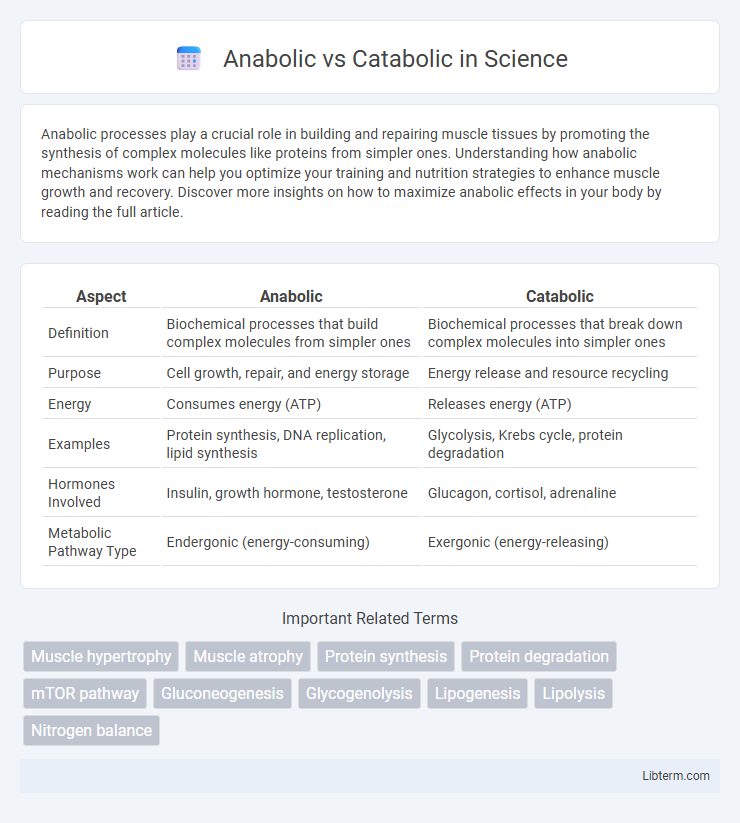Anabolic processes play a crucial role in building and repairing muscle tissues by promoting the synthesis of complex molecules like proteins from simpler ones. Understanding how anabolic mechanisms work can help you optimize your training and nutrition strategies to enhance muscle growth and recovery. Discover more insights on how to maximize anabolic effects in your body by reading the full article.
Table of Comparison
| Aspect | Anabolic | Catabolic |
|---|---|---|
| Definition | Biochemical processes that build complex molecules from simpler ones | Biochemical processes that break down complex molecules into simpler ones |
| Purpose | Cell growth, repair, and energy storage | Energy release and resource recycling |
| Energy | Consumes energy (ATP) | Releases energy (ATP) |
| Examples | Protein synthesis, DNA replication, lipid synthesis | Glycolysis, Krebs cycle, protein degradation |
| Hormones Involved | Insulin, growth hormone, testosterone | Glucagon, cortisol, adrenaline |
| Metabolic Pathway Type | Endergonic (energy-consuming) | Exergonic (energy-releasing) |
Understanding Anabolic and Catabolic Processes
Anabolic processes involve the synthesis of complex molecules from simpler ones, requiring energy input to build tissues such as muscle and bone. Catabolic processes break down complex molecules into simpler ones, releasing energy stored in chemical bonds for cellular functions. Understanding the balance between anabolic and catabolic activities is essential for optimizing metabolism, growth, and overall health.
Key Differences Between Anabolic and Catabolic States
Anabolic and catabolic states represent opposing metabolic processes, with anabolic pathways focused on muscle growth, protein synthesis, and energy storage, while catabolic pathways involve breaking down molecules to release energy. Key differences include that anabolic processes require energy input to build complex molecules, whereas catabolic processes release energy by degrading complex substrates like fats and proteins. Hormones like insulin promote anabolic activity, whereas cortisol and glucagon trigger catabolic responses, making these states critical in regulating body composition and energy balance.
Role of Hormones in Anabolic and Catabolic Pathways
Anabolic hormones such as insulin, growth hormone, and testosterone stimulate pathways that promote protein synthesis, muscle growth, and tissue repair by enhancing cellular uptake of amino acids and activating mTOR signaling. Catabolic hormones like cortisol and glucagon trigger the breakdown of glycogen, fats, and proteins to release energy, primarily by activating enzymes involved in gluconeogenesis, lipolysis, and proteolysis. The balance between these hormone-driven anabolic and catabolic pathways regulates metabolism, energy homeostasis, and overall physiological adaptation to stress and exercise.
Effects on Muscle Growth and Breakdown
Anabolic processes stimulate muscle growth by promoting protein synthesis and increasing muscle fiber size, essential for hypertrophy and strength gains. Catabolic processes lead to muscle breakdown by degrading muscle proteins, often triggered by stress hormones like cortisol, which hinders recovery and reduces muscle mass. Balancing anabolic and catabolic activities is crucial for optimizing muscle growth and preventing muscle loss during training and recovery phases.
Energy Utilization: Building vs. Breaking Down
Anabolic processes consume energy to build complex molecules such as proteins and nucleic acids from simpler ones, essential for growth and repair. Catabolic pathways release energy by breaking down complex molecules like carbohydrates, fats, and proteins into simpler compounds. This energy release drives cellular activities, powering functions like muscle contraction and biosynthesis.
Nutrition Strategies for Anabolic and Catabolic Balance
Optimizing anabolic and catabolic balance through nutrition involves prioritizing protein intake to support muscle synthesis and recovery while managing carbohydrate and fat consumption to regulate energy and hormone levels. Consuming adequate calories with a focus on nutrient timing, such as post-workout protein and carbohydrate meals, enhances anabolic processes and limits muscle breakdown. Micronutrients like zinc, magnesium, and vitamin D play a crucial role in hormone regulation, aiding in maintaining an effective balance between anabolic muscle-building and catabolic muscle degradation.
Exercise Impacts: Promoting Anabolism or Catabolism
Exercise impacts the balance between anabolic and catabolic processes by stimulating muscle protein synthesis during resistance training, promoting anabolism for muscle growth and repair. Endurance exercise often increases catabolic activity by enhancing the breakdown of glycogen and fat for energy, supporting sustained performance. Proper nutrition and recovery optimize anabolic responses, while excessive training without adequate rest can lead to prolonged catabolism and muscle degradation.
Common Misconceptions About Anabolic and Catabolic Processes
Anabolic processes are often misunderstood as solely muscle-building, while they also include key functions like tissue repair and hormone production. Catabolic processes are frequently viewed as negative for causing muscle breakdown, but they are essential for energy release and metabolic balance. Both processes work synergistically to maintain homeostasis and support overall health.
Health Implications of Chronic Catabolic vs. Anabolic States
Chronic catabolic states lead to muscle wasting, impaired immune function, and increased risk of chronic diseases such as osteoporosis and cardiovascular disorders due to the sustained breakdown of tissues and energy stores. Persistent anabolic dominance, while promoting muscle growth and tissue repair, can cause metabolic imbalances, insulin resistance, and increased risk of hypertrophy-related complications if unregulated. Balancing anabolic and catabolic processes is crucial for maintaining overall health, metabolic homeostasis, and optimal physical function.
Optimizing Your Lifestyle for Anabolic Dominance
Optimizing your lifestyle for anabolic dominance involves prioritizing muscle growth, recovery, and hormonal balance through nutrient-dense meals rich in proteins, essential fats, and complex carbohydrates. Resistance training combined with adequate rest and stress management supports anabolic pathways by increasing testosterone and growth hormone levels. Consistent sleep patterns and minimizing catabolic stimuli, such as excessive cardio or prolonged fasting, further enhance muscle synthesis and overall anabolic efficiency.
Anabolic Infographic

 libterm.com
libterm.com